WORLD CLASS COACHING
40 Fun Games For Young Players
By Luca Bertolini
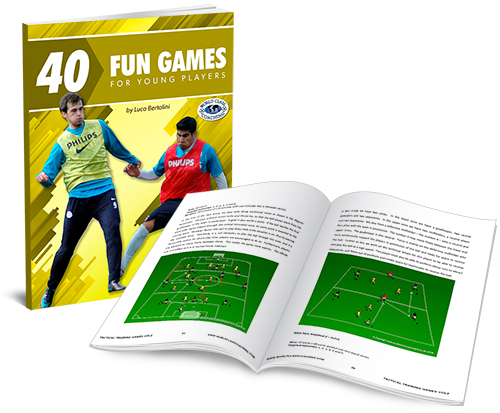
Table of Contents
PART TWO
Fun Games
Fun Games
Exercise 1: follow the compass (1)

Set-up and sequence: all the available players are placed inside a rectangular area of different dimensions, depending on age and level of the children. The sides of the rectangle are named with cardinal points. The players dribble the ball freely at the beginning (1); when the coach calls out a cardinal point (south, in the picture), the players must turn and dribble the ball out toward the corresponding side (2). The children should pay attention not to collide while dribbling or changing direction.
Variations:
• The players can be asked dribbling with a specific part of the foot (flat, instep, sole), alternating the feet, changing direction with another foot or part of a foot.
• Fix a limit of time to dribble the ball out.
• Ask the players to dribble out toward the opposite cardinal point from the one that is called out.
• Ask a player to call out a cardinal point while dribbling during the first phase.
Coaching points: quality of dribbling, feet rhythm while dribbling, quick reactions to change direction.
Exercise 2: follow the compass (2)

Set-up Set-up and sequence and sequence: this practice is a progression of the previous one. 4 more players (or 4 of the previous game) are defenders (yellow ones), who can run freely along the side where they are placed. The black players with the ball dribble freely at the beginning (1); when the coach calls out a cardinal point (south in the picture), the players must turn and dribble the ball out toward the corresponding side (2), preventing the defender from recovering the possession against one of them. The children should pay attention not to collide while dribbling or changing direction and to keep the possession. If the defender wins the ball, he becomes attacker and the opponent becomes defender.
Variations:
• Fix a limit of time to dribble the ball out
• Ask the players to dribble out toward the opposite cardinal point from the one that is called out
• Ask a player to call out a cardinal point while dribbling during the first phase
• Ask a defender to invite the attackers toward him
Coaching points: look for the best timing to dribble out preventing any opposition, quality of dribbling, feet rhythm while dribbling, quick reactions to change direction, avoid defender's tackle.
Exercise 3: defend the territory (1)
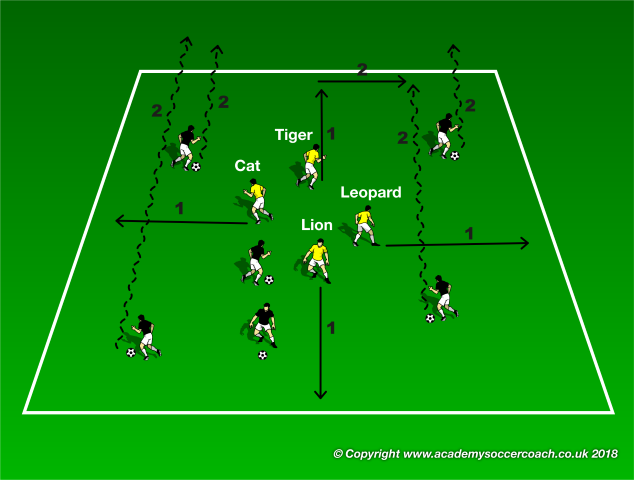
Set-up and sequence: all the available players are placed inside a rectangular area of different dimensions, depending on age and level of the children. 4 of them are defenders (yellow ones) and they are identified with names of animals; they can run freely along the side where they are placed, after the coach's sign. The black players with the ball dribble freely at the beginning; when the coach calls out an animal, the players must turn and dribble the ball out of the rectangle, overcoming the side where the called animal is placed, avoiding any tackle attempt (2). While the attackers change direction, the defender must try to protect the territory, recovering one ball from the attackers (2). If the defender wins the ball, he becomes attacker and the opponent becomes defender.
Variations:
• Fix a limit of time to dribble the ball out
• The coach can call the animals one after the other, to encourage changes of directions with the ball
Coaching points: quality of dribbling, quick reactions to change direction, avoid defender's tackle, memorize the opponents, look at the position of the opponent, choose the easiest situation to recover the possession, reaction speed.
Exercise 4: defend the territory (2)
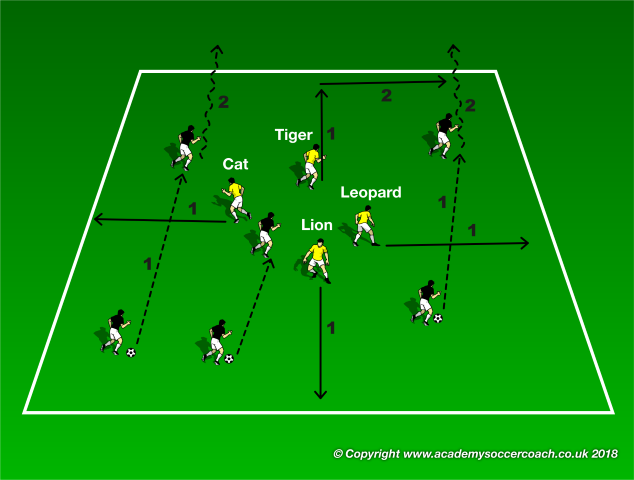
Set-up and sequence: this is a variation of the previous exercise. All the available players are placed inside a rectangular area of different dimensions, depending on age and level of the children. 4 of them are defenders (yellow ones) and they are identified with names of animals; they can run freely along the side where they are placed, after the coach's sign. Half of the black players have the possession and they dribble freely at the beginning; the other half must move properly to be ready to receive. When the coach calls out an animal, the black players must pass the ball to the teammates, who must be well positioned to receive and to dribble the ball out of the rectangle, overcoming the side where the called animal is placed, avoiding any tackle attempt (2). While the attackers change direction, the defender (the called animal) must try to save the territory, recovering one ball from the attackers (2). If the defender wins the ball, he becomes attacker and the opponent becomes defender.
Variations:
• Fix a limit of time to dribble the ball out
• The coach can call the animals one after the other, to encourage changes of directions with the ball
• The called animal is allowed running back inside the rectangle to counter a forward and to save his territory
Coaching points: correct body position to receive, quality of dribbling, quick reactions to change direction, avoid defender's tackle, memorize the opponents, look at the position of the opponent, choose the easiest situation to recover the possession.
Exercise 5: conquer the oceans or bring the ball safe on the land (1)
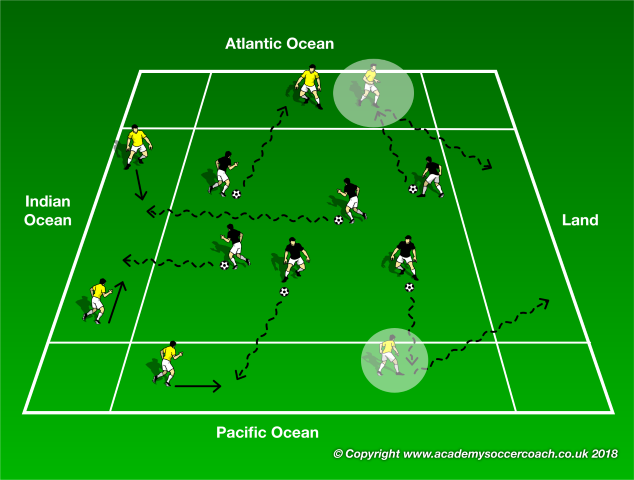
Set-up and sequence: a rectangular area is marked as in the picture, with 4 outer areas and a center one. The defenders are placed inside 3 of these areas and they must save the oceans at their back (2 defenders inside each area); 6 black forwards are in possession of a ball each in the middle space of the set-up and they must attack the defense lines to conquer the oceans, dribbling the ball over the end line (2 forwards attack each ocean). They dribble freely at the beginning, but they must be organized and pay attention to the ocean to attack, as they must be paired and play 1 v 1 duels near each "ocean line". If the defenders win the ball, they must dribble freely toward the land (the fourth outer area) to win the point and to switch the roles of the teams, when the sequence starts again. The black player who lost the possession can track him to win the ball back again.
Variations:
• The forwards must able to keep the possession for 6"-8" inside the outer area. This is the time limit to recover the possession and dribble the ball to the land.
• The defenders can run inside the center area to win the ball for 6".
Coaching points: quality of dribbling, quick reactions to change direction, avoid defender's tackle, look at the position of the opponent, counter-pressing to win the ball back, pay attention to find the "right ocean" to attack.
Exercise 6: conquer the oceans or bring the ball safe on the land (2)
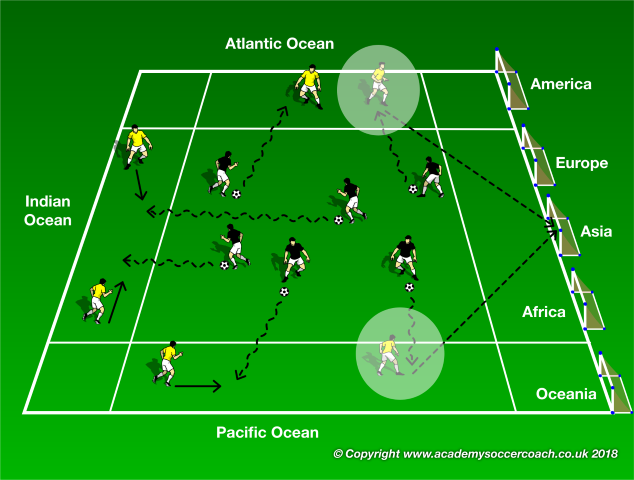
Set-up and sequence: this exercise is a progression of the previous one. A rectangular area is marked as in the picture, with 4 outer areas and a center one. 5 goals are named as continents and they are placed along the fourth side, as in the picture. The defenders are placed inside 3 of these outer areas and they must save the oceans at their back (2 defenders inside each area); 6 black forwards are in possession of a ball in the middle space of the set-up and they must attack the defense lines to conquer the oceans, dribbling the ball over the end line (2 forwards attack each ocean). They dribble freely at the beginning, but they must be organized and pay attention to the ocean to attack, as they must be paired and play 1 v 1 duels near each "ocean line". If the defenders win the ball, they must shoot toward the land, scoring in one of the mini-goals that are named as continents, to switch the roles of the teams, when the sequence starts again. The black player who lost the possession must be very fast to prevent a shooting attempt.
Variations:
• The forwards must able to keep the possession for 6"-8" inside the outer area. This is the time limit to recover the possession and dribble the ball to the land.
• The defenders can run inside the center area, to shot or to win the ball for 6".
Coaching points: quality of dribbling, quick reactions to change direction, avoid defender's tackle, look at the position of the opponent, pay attention to find the right ocean to attack, quick individual transition.
Exercise 7: states and cities (1)
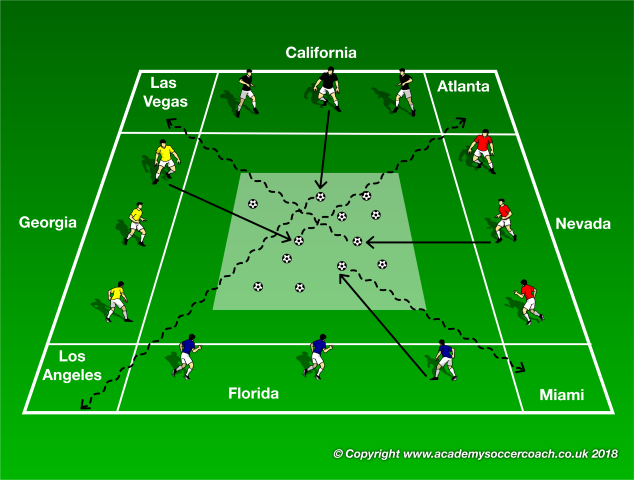
Set-up and sequence: the set-up of this exercise is the same of the previous two. A rectangular area is marked as in the picture, with 4 outer areas and a center one. Each outer area is named as a US State, as in the picture; the corners are named as the main cities of each state; a center area in the middle includes the balls that must be brought to the corresponding city. 4 teams of 3 players each are placed inside the outer "state" areas. When the coach asks to start, one player for each team must run toward the balls area and dribble to the right city on the corners; the game goes on this way one player after the other. When the balls in the middle are finished, they can be stolen from the other team cities, until a team wins, when a city is empty.
Variations:
• Vary the names of the states and of the cities
• Change the corners of the cities at every sequence to encourage different changes of direction
Coaching points: quick reactions to arrive on the ball and to change direction, pay attention to find the right city if it changes after each sequence, sprint skills to steal the ball to the other teams.
Exercise 8: states and cities (2)
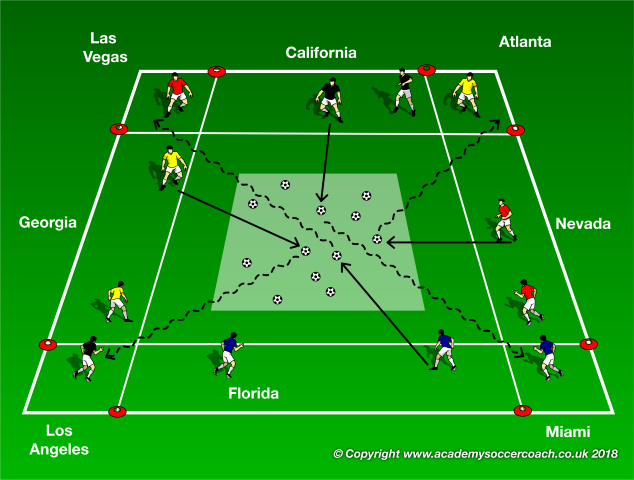
Set-up and sequence: the set-up of this exercise is the same of the previous two. A rectangular area is marked as in the picture, with 4 outer areas and a center one. 4 teams of 3 players are placed inside the outer areas. Each outer area is named with as a US State, as in the picture; the corners are the areas that are named with the main cities of each state and they are protected by a defender. A center zone in the middle includes the balls that must be brought to the correspondent city. When the coach asks to start, one player for each team must run toward the balls area and dribble to the right city on the corners, playing a 1 v 1 duel against the "city defender" and dribbling the ball over the red cone diagonal lines. The game goes on this way one player after the other, until the ball in the center are finished.
Variations:
• Vary the names of the states, of the cities
• Change the corners of the cities at every sequence to encourage different changes of direction
Coaching points: quick reactions to arrive on the ball and to change direction, pay attention to find the right city if it changes after each sequence, 1 v 1 skills to defend and to attack a small space without losing the possession.
Exercise 9: shooting tic-tac-toe (1)
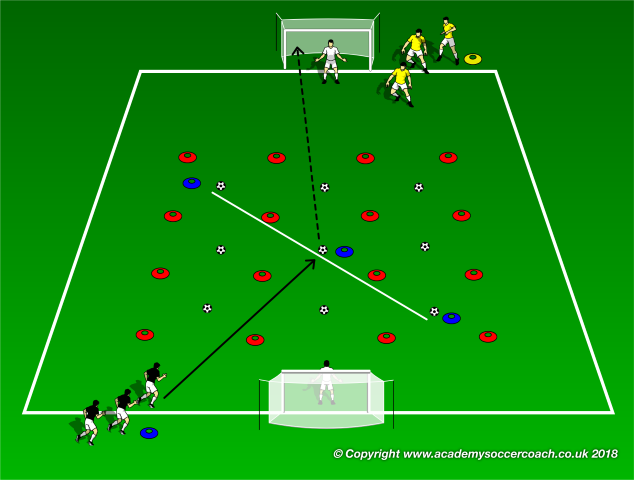
Set-up and sequence: a rectangular area is set-up with 2 goals and goalkeepers in the center of the shorter sides and a tic-tac-toe set-up is placed in the middle, as in the picture. Balls are placed inside each square. The players of each team (3 blacks and 3 yellows) start from the left side (or right) of the goal and behind the end line and all them carry a cone in their hand. Each player of both teams must run one after the other toward a ball, deciding which is the best square, and shoot toward the opposition goal trying to score; shots must be kicked with 1 touch. If the player scores, he can put the cone on the ground; but if he can't score, he must bring the ball back into the starting place. The team who is able to complete the tic-tac-toe sequence (as the black team does in the picture) wins the round.
Coaching points: find the best solution to complete the tic-tac-toe sequence, shot with the natural foot on the ball (don't force shoots with the strong foot), run properly to be ready to shoot.
Exercise 10: shooting tic-tac-toe (2)
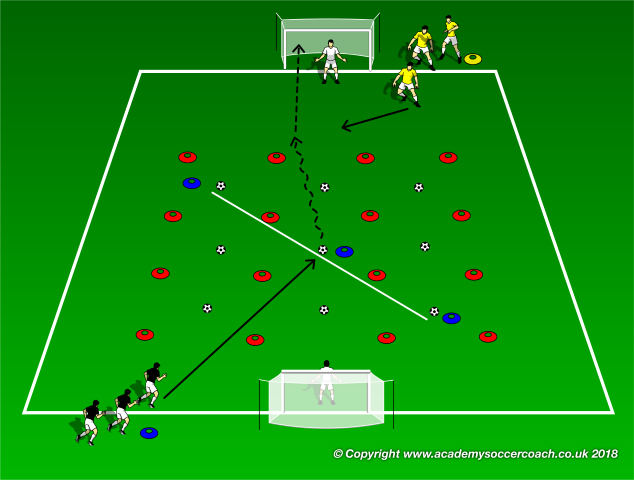
Set-up and sequence: a rectangular area is set-up with 2 goals and goalkeepers in the center of the shorter sides and a smaller tic-tac-toe structure is placed in the middle, as in the picture. Balls are placed inside each square. The players of each team (3 blacks and 3 yellows) start from the left side (or right) of the goal and behind the end line and all carry a cone in their hand. Each player of both teams must run one after the other toward a ball, deciding which is the best square, dribble it out of set-up and shoot toward the opposition goal trying to score, after a 1 v 1 duel against a defender of the opposition team. If the player scores, he can put the cone on the ground; but if he can't score, he must bring the ball back into the starting place. If the defender wins the possession, he can't put his cone, instead of the prior attacking player. The team who is able to complete the tic-tac-toe sequence (as the black team does in the picture) wins the round.
Coaching points: find the best solution to complete the tic-tac-toe sequence, win the 1 v 1 duel as quickly as possible, finish the move shooting on goal as soon as possible, decide if to counter the opponent directly or to close the goal space.
Exercise 11: hit the cone and shot on goal

Set-up and sequence: 2 teams of 3 players (or whatever the number of available players is, but an even number) are placed inside a rectangular area with 2 goals and goalkeepers in the center of the shorter sides of the set-up. Triangle shapes are placed all over the playing area, as in the picture; yellow triangles are used by the yellow team and the orange ones are used by the black team. All the players dribble the ball freely until a sign of the coach; after it, they must stop the ball along the lines on the lower sides of the triangles and then hit the top bigger cone. If they hit it, they can shot toward the further goal, after a change of direction; if they can't, they must dribble the ball away, waiting for a second attempt. 2 touches are required after hitting the top cone. The team who scores more goals after a fix period of time wins the round.
Variation: the coach may requires a specific foot or part of the foot to dribble first and then to shot.
Coaching points: weight of ball touch to hit the cone without sending it too far away, touches quality to shot and score quickly, dribble at high tempo.
Exercise 12: bowling and shots on goal (1)
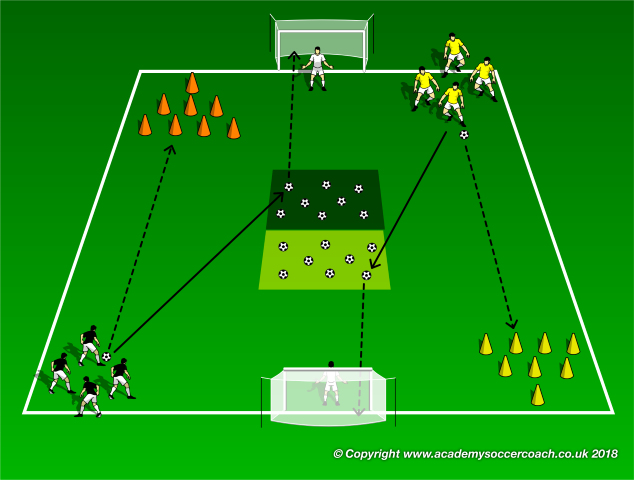
Set-up and sequence: 2 teams of 4 players (or whatever the number of available players is) are placed at the opposite corners of a rectangular area. 2 goals with goalkeepers are placed along the shorter sides of the rectangle, 2 "trees" of cones are placed on the free corners, as in the pictures, and 2 box areas with 8 balls each are placed in the middle of the set-up. The goals for each team are to hit the cones in front of them (yellow for yellow players and orange for black team) and then to shot on goal one of the ball inside the further center area (1 touch shot with the right foot in the picture); the goal worth the same quantity of prior hit cones. Points are gained only after scoring.
Variation:
• Reverse the corners to shot with the other foot
• Add a defender in front of each goal
Coaching points: be aware while kicking the ball toward the cones, weight of touches to try to hit more than one cone, run properly to be able to shot with a single touch.
Exercise 13: bowling and shots on goal (2)
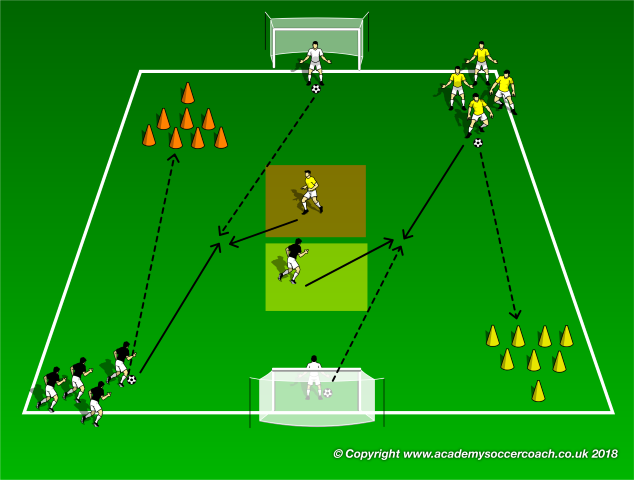
Set-up and sequence: this exercise is a progression of the previous one. 2 teams of 4 players (or whatever the number of available players is) are placed at the opposite corners of a rectangular area. 2 goals with goalkeepers in possession of a ball are placed along the shorter sides of the rectangle, 2 "trees" of cones are placed on the free corners, as in the pictures, and 2 box areas with a defender of each team are placed in the middle of the set-up. The goals for each team are to hit the cones in front of them (yellow for yellow players and orange for black team) and then to shot on goal after receiving a pass from the opposition goalkeepers and winning 1 v 1 duels against the defenders; the goal worth the same quantity of prior hit cones. Points are gained only after scoring. If the defenders win the ball, they can shoot toward the opposition goal, doubling the value of the potential scoring of the attacking teammates.
Variation:
• Reverse the corners to shot with the other foot
Coaching points: be precise while kicking the ball toward the cones, weight of touches to try to hit more than one cone, run properly to be able to receive without losing the ball control, win the 1 v 1 duel as quickly as possible, try to overcome the opponents without losing the goal space.
Exercise 14: tigers zoo (1)
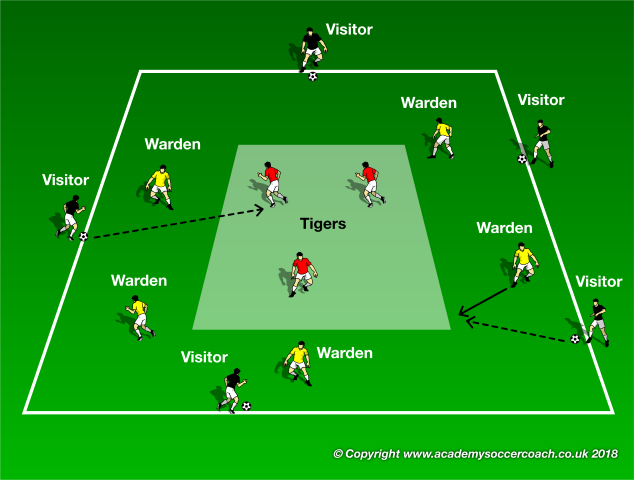
Set-up and sequence: the rectangular set-up is considered as a tigers' zoo. The 5 visitors (players in possession of a ball each) are free to dribble along the border lines of the playing area, 3 red tigers are placed inside another zone in the middle and 5 wardens (defenders) can move freely along the area between the center zone and the border lines, trying to prevent the visitors (attackers) from passing toward the tigers. Each completed pass is a point for the attacking team. If a defender wins the ball, he gains a point for his team. The tigers must always move around the middle area to be sure to be unmarked at the back of the wardens.
Coaching points: close the passing lanes, be unmarked at the back and find the right space dribbling the ball.
Exercise 15: tigers zoo (2)
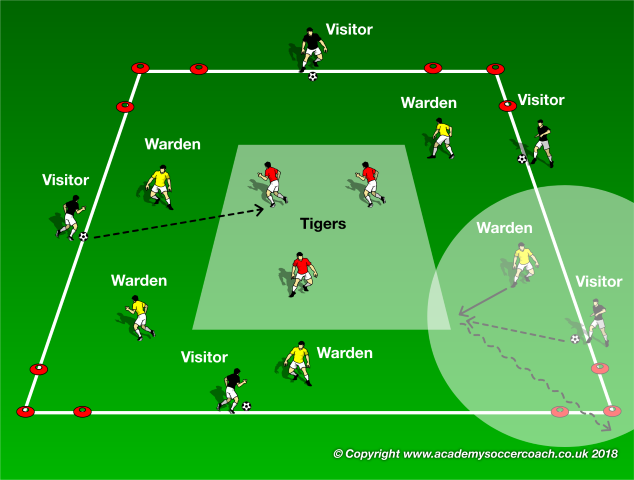
Set-up and sequence: this exercise is a progression of the previous one. The rectangular set-up is considered as a tigers' zoo. Corner goals are now added using red cones, as in the picture. The 5 visitors (the players in possession of a ball each) are free to dribble along the border lines of the playing area, 3 red tigers are placed inside another zone in the middle and 5 wardens (defenders) can move freely along the area between the center zone and the border lines, trying to prevent the visitors (attackers) from passing toward the tigers. Each completed pass is a point for the attacking team. If a defender wins the ball, he must dribble to ball out of the nearest and easiest corners gate to gain a point for his team. The tigers must always move around the middle area to be sure to be unmarked at the back of the wardens.
Coaching points: close the passing lanes, be unmarked at the back, find the right space dribbling the ball, counter-pressing and individual transitions.


